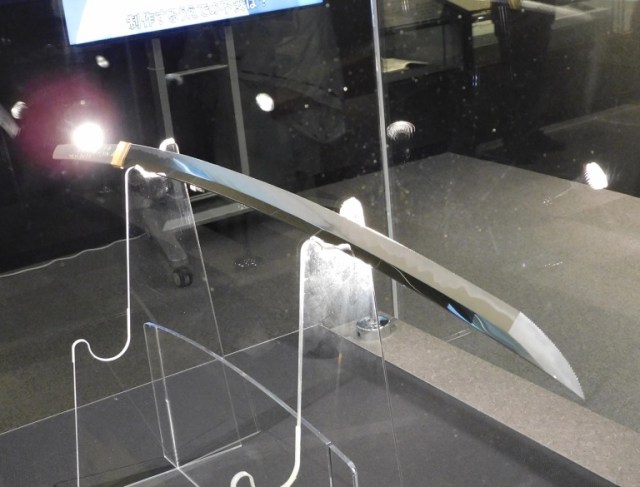
Kenshin vs. Shishio museum exhibit displays Sakabato and Mugenjin.
Within anime/manga Rurouni Kenshin, Himura Kenshin and Shishio Makoto can be considered two sides of the same coin. They’re both supremely skilled swordsmen who worked as assassins for the government, but while protagonist Kenshin’s realization that violence only creates sorrow leads him to vow to never again take a life, Shishio descends further and further into blood-soaked madness.
The pair’s personalities are reflected in their swords, with Kenshin’s Sakabato having what would ordinarily be the katana’s striking edge left dull and unsharpened, while Shishio’s Mugenjin is crafted to kill as efficiently as possible.
Both swords were fictional weapons created for the manga, until a few years ago when Japanese swordsmiths created an actual Sakabato. Now a real-life Mugenjin has been crafted too, and both blades are currently on display in a special museum exhibit.
Titled Kenshin vs. Shishio: Rurouni Kenshin and the World of Japanese Swords, the exhibit is being held in the town of Seki, Gifu Prefecture. During the samurai era, Seki’s smiths earned a reputation for producing some of the finest swords in the country for the warrior class, and even now the city is known for high-class cutlery of non-combat natures.
The venue for the exhibit is the Seki Sword Tradition Museum (Seki Kajidenshokan in Japanese), about a five-minute walk from Sekiterasumae Station on the Etsumi-Nan Line. Signs emblazoned with images of Kenshin and Shishio around town and in front of the museum let you know you’re in the right place.
The exhibition is being held on the second floor, and the first sword you’ll encounter as you come into the room is the Sakabato (逆刃刀), with the Mugenjin (無限刃) behind it.
▼ Officially, the real-life version of Kenshin’s sword is called the Sakabato Shinuchi
(逆刃刀真打), Shinuchi meaning “Truly Forged” in Japanese.
The Sakabato was just as beautiful as it was the last time we saw it. This was our first time to lay eyes on the Mugenjin, though, and it’s a fearsome blade to behold.
From across the room, you might not immediately spot what makes it so suited to Shishio’s merciless nature, but as you get closer…
…you’ll see it has a serrated edge.
Part of what makes katana such compelling works of art is their mix of grace and power. They’re bladed weapons, first and foremost, but their shine and undulated hamon tempering lines give them an almost liquid visual quality. Looking at the Mugenjin, though, there’s a strong intimidating aura, as it’s hard not to imagine the sawtooth edge ripping through its target instead of making a clean cut.
Within the anime, the Mugenjin’s design is said to enable the sword to self-sharpen as it slices so that it never dulls, no matter how many people Shishio cuts down with it. We’re not sure the design would have that effect in the real world, but it’s still an amazingly impressive work of swordsmithing. We asked Fujiwara no Kanafune, one of the craftsmen who helped make the real-life Mugenjin (and the 26th generation of swordsmith to bear that name) how he produced the one-of-a-kind katana edge, but he only told us “That’s a secret.”
By the way, there’s one more Rurouni Kenshin-related sword at the exhibit, which is right next to the character artwork of Saito Hajime.
Saito is yet another swordsman who appears in the series, and on display in the case beside his picture is his sword.
However, this sword wasn’t made because of Rurouni Kenshin. Unlike Kenshin and Shishio, Saito Hajime was an actual historical figure, a samurai who lived in Japan during the Edo period and was a high-ranking member of the Shinsengumi special police force, and on display at the museum is the sword of the real-life Saito, creating a unique mixing of the anime/manga series and actual Japanese history.
The Kenshin vs. Shishio: Rurouni Kenshin and the World of Japanese Swords exhibit is going on now and runs until March 30.
Museum information
Seki Sword Tradition Museum / 関鍛冶伝承館
Address: Gifu-ken, Seki-shi, Minamikasugacho 9-1
岐阜県関市南春日町9-1
Open 9 a.m.-4:30 p.m.
Admission: 500 yen
Exhibition website
Photos © SoraNews24
● Want to hear about SoraNews24’s latest articles as soon as they’re published? Follow us on Facebook and Twitter!
[ Read in Japanese ]

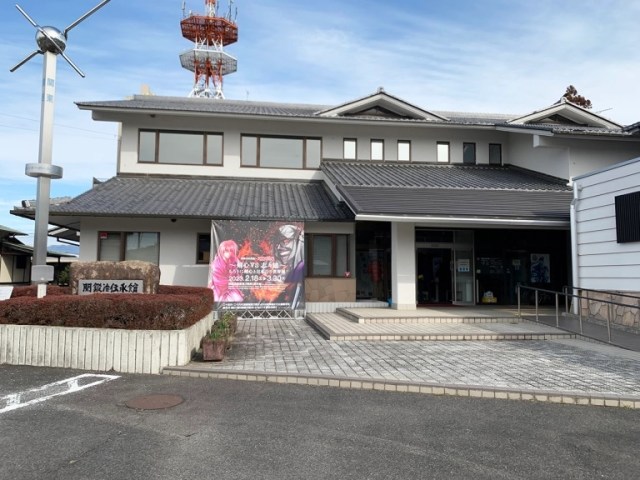
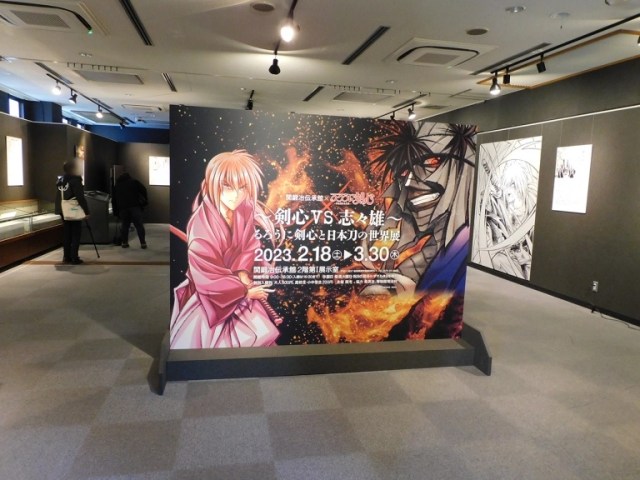
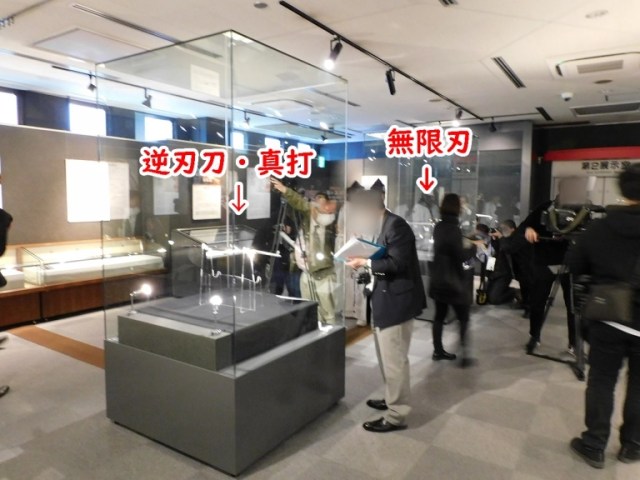
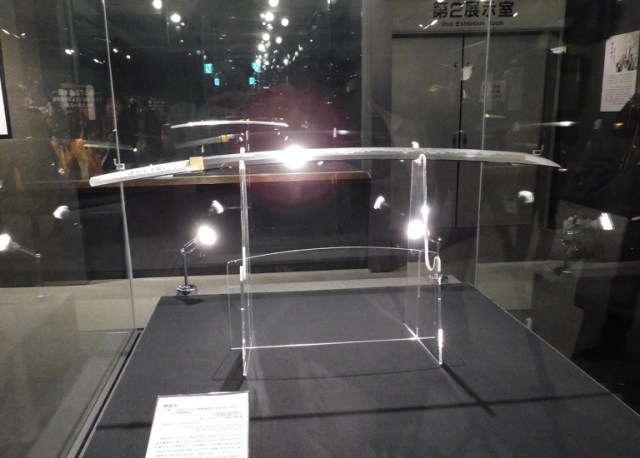
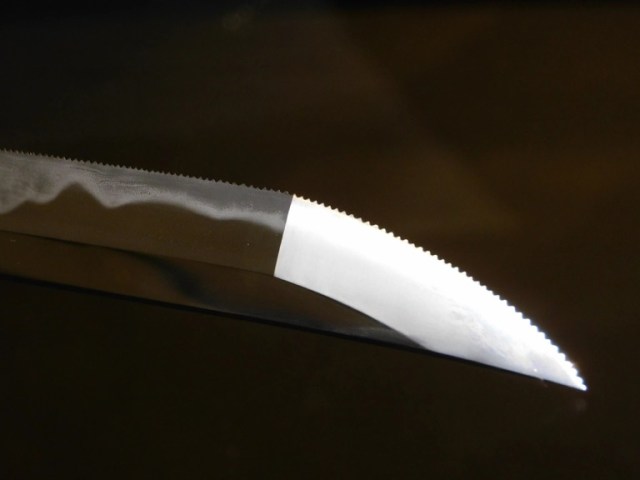
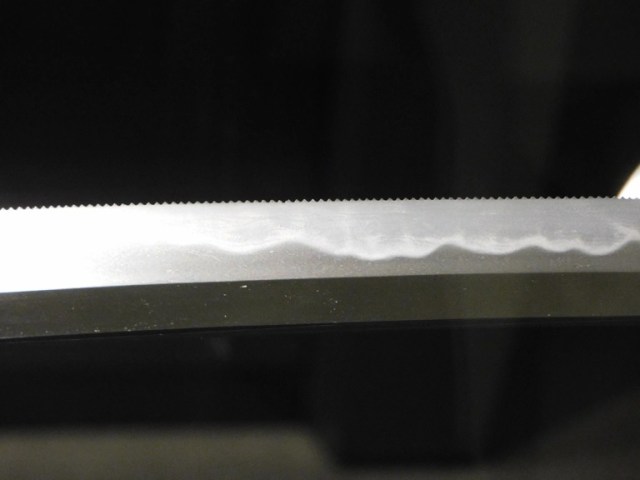
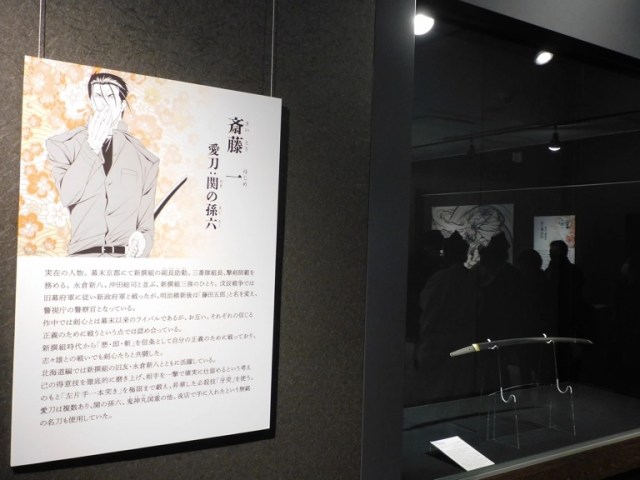
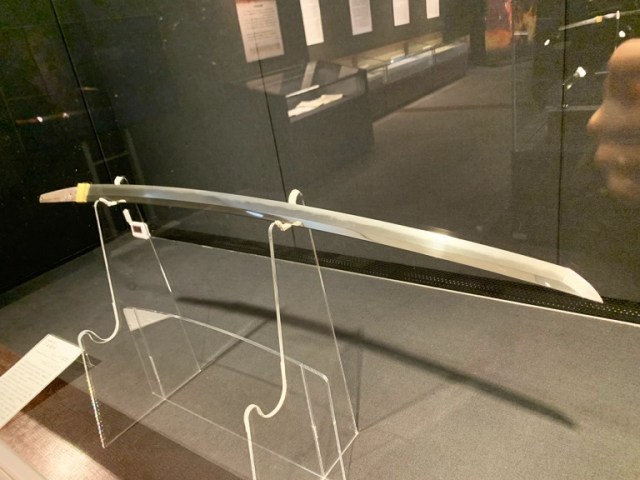
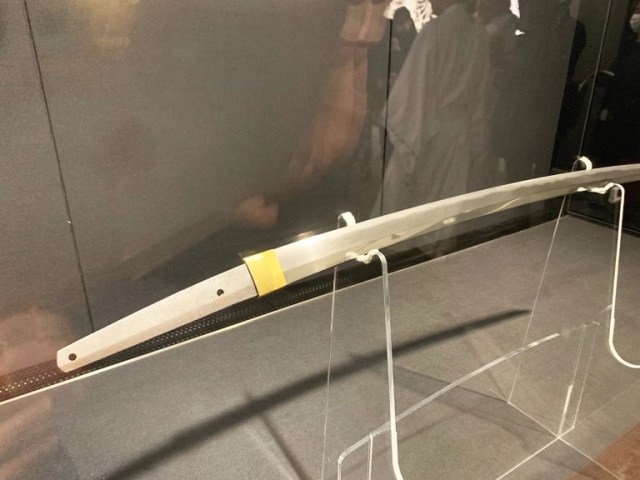
 Real-life Rurouni Kenshin reverse-blade katana, forged by master swordsmith, now on display【Pics】
Real-life Rurouni Kenshin reverse-blade katana, forged by master swordsmith, now on display【Pics】 Real-life Rurouni Kenshin reverse-blade sword to be displayed in Tokyo
Real-life Rurouni Kenshin reverse-blade sword to be displayed in Tokyo Real-life Rurouni Kenshin reverse-blade katana now on display in Tokyo【Photos】
Real-life Rurouni Kenshin reverse-blade katana now on display in Tokyo【Photos】 Swords of famous samurai reborn as beautiful kitchen knives from Japan’s number-one katana town
Swords of famous samurai reborn as beautiful kitchen knives from Japan’s number-one katana town One Piece anime katanas recreated as exquisite letter openers by Japan’s swordsmith legacy heirs
One Piece anime katanas recreated as exquisite letter openers by Japan’s swordsmith legacy heirs Japan’s new difficult-to-drink-from beer glass protects your liver, but it’s a brutal experience
Japan’s new difficult-to-drink-from beer glass protects your liver, but it’s a brutal experience New Nintendo Lego kit is a beautiful piece of moving pixel art of Mario and Yoshi【Photos】
New Nintendo Lego kit is a beautiful piece of moving pixel art of Mario and Yoshi【Photos】 Come play hide-and-seek on a deserted Japanese island this August and November
Come play hide-and-seek on a deserted Japanese island this August and November To combat declining birth rate, Japan to begin offering “Breeding Visas” to foreigners
To combat declining birth rate, Japan to begin offering “Breeding Visas” to foreigners How to order snacks on a Shinkansen bullet train in Japan
How to order snacks on a Shinkansen bullet train in Japan Demon Slayer: Kimetsu no Yaiba gets new roller coaster attractions and food at Universal Studios Japan
Demon Slayer: Kimetsu no Yaiba gets new roller coaster attractions and food at Universal Studios Japan High-fashion Totoro cuddle purse is like an elegant stroll in the forest【Photos】
High-fashion Totoro cuddle purse is like an elegant stroll in the forest【Photos】 New Pokémon ice cream, dessert drinks, and cool merch coming to Baskin-Robbins Japan【Pics】
New Pokémon ice cream, dessert drinks, and cool merch coming to Baskin-Robbins Japan【Pics】 Hello, cosmetics! Clinique teams up with Hello Kitty this summer for first-time collaboration
Hello, cosmetics! Clinique teams up with Hello Kitty this summer for first-time collaboration We check out the local flavors of the commonly confused Ome and Aomi areas of Tokyo in one day
We check out the local flavors of the commonly confused Ome and Aomi areas of Tokyo in one day Nintendo history you can feel – Super NES, N64, and GameCube controllers become capsule toys
Nintendo history you can feel – Super NES, N64, and GameCube controllers become capsule toys “The most Delicious Cup Noodle in history” – Japan’s French Cup Noodle wins our heart【Taste test】
“The most Delicious Cup Noodle in history” – Japan’s French Cup Noodle wins our heart【Taste test】 Starbucks releases a cute Frappuccino and Unicorn Cake…but not in Japan
Starbucks releases a cute Frappuccino and Unicorn Cake…but not in Japan Kyoto Tower mascot termination reveals dark side behind cute Japanese characters
Kyoto Tower mascot termination reveals dark side behind cute Japanese characters McDonald’s Japan’s Soft Twist Tower: A phantom ice cream only sold at select branches
McDonald’s Japan’s Soft Twist Tower: A phantom ice cream only sold at select branches Yabai Ramen: What makes this Japanese ramen so dangerous?
Yabai Ramen: What makes this Japanese ramen so dangerous? Finally! Nintendo Japan expands Switch 8-bit controller sales to everybody, Online member or not
Finally! Nintendo Japan expands Switch 8-bit controller sales to everybody, Online member or not Japanese government wants to build luxury resorts in all national parks for foreign tourists
Japanese government wants to build luxury resorts in all national parks for foreign tourists 10 things you should buy at 7-Eleven in Japan
10 things you should buy at 7-Eleven in Japan Studio Ghibli releases anime heroine cosplay dresses that are super comfy to wear
Studio Ghibli releases anime heroine cosplay dresses that are super comfy to wear Woman charged for driving suitcase without a license in Osaka
Woman charged for driving suitcase without a license in Osaka Studio Ghibli unveils My Neighbour Totoro miniature house model
Studio Ghibli unveils My Neighbour Totoro miniature house model Kyoto experiencing problems with foreign tourists not paying for bus fares, but not on purpose
Kyoto experiencing problems with foreign tourists not paying for bus fares, but not on purpose Fighting mild hunger with a Japanese soda that turns into jelly in the stomach【Taste test】
Fighting mild hunger with a Japanese soda that turns into jelly in the stomach【Taste test】 Studio Ghibli’s Howl’s Moving Castle tapestry unveiled in Japan for first time
Studio Ghibli’s Howl’s Moving Castle tapestry unveiled in Japan for first time McDonald’s new Happy Meals offer up cute and practical Sanrio lifestyle goods
McDonald’s new Happy Meals offer up cute and practical Sanrio lifestyle goods Sales of Japan’s most convenient train ticket/shopping payment cards suspended indefinitely
Sales of Japan’s most convenient train ticket/shopping payment cards suspended indefinitely Sold-out Studio Ghibli desktop humidifiers are back so Totoro can help you through the dry season
Sold-out Studio Ghibli desktop humidifiers are back so Totoro can help you through the dry season Japanese government to make first change to romanization spelling rules since the 1950s
Japanese government to make first change to romanization spelling rules since the 1950s Foreigner’s request for help in Tokyo makes us sad for the state of society
Foreigner’s request for help in Tokyo makes us sad for the state of society Ghibli founders Toshio Suzuki and Hayao Miyazaki contribute to Japanese whisky Totoro label design
Ghibli founders Toshio Suzuki and Hayao Miyazaki contribute to Japanese whisky Totoro label design Doraemon found buried at sea as scene from 1993 anime becomes real life【Photos】
Doraemon found buried at sea as scene from 1993 anime becomes real life【Photos】 Tokyo’s most famous Starbucks is closed
Tokyo’s most famous Starbucks is closed Princesses, fruits, and blacksmiths: Study reveals the 30 most unusual family names in Japan
Princesses, fruits, and blacksmiths: Study reveals the 30 most unusual family names in Japan Rurouni Kenshin comes to picture-perfect life as photos of stage musical’s cast are released
Rurouni Kenshin comes to picture-perfect life as photos of stage musical’s cast are released “Katana steel cookies” are the latest sweet treat from Japan’s samurai sword capital【Taste test】
“Katana steel cookies” are the latest sweet treat from Japan’s samurai sword capital【Taste test】 Japanese samurai sword ice cream crafted by master swordsmith from famous katana town of Seki
Japanese samurai sword ice cream crafted by master swordsmith from famous katana town of Seki Rurouni Kitty! Sanrio’s beloved cat cosplays as anime’s iconic swordsman in plushie form
Rurouni Kitty! Sanrio’s beloved cat cosplays as anime’s iconic swordsman in plushie form Japan’s legendary Brother Katana might not be brothers after all? Investigating the mystery【Pics】
Japan’s legendary Brother Katana might not be brothers after all? Investigating the mystery【Pics】 Samurai sword hunt begins as storm washes away blacksmith’s warehouse in Gifu Prefecture
Samurai sword hunt begins as storm washes away blacksmith’s warehouse in Gifu Prefecture This hotel has one of the coolest katana collections in Japan, and admission is totally free【Pics】
This hotel has one of the coolest katana collections in Japan, and admission is totally free【Pics】 Katana of four of Japan’s greatest samurai turned into gorgeous scissors
Katana of four of Japan’s greatest samurai turned into gorgeous scissors Demon-slaying Dojigiri, one of Japan’s Five Swords Under Heaven, now on display at Kasuga Shrine
Demon-slaying Dojigiri, one of Japan’s Five Swords Under Heaven, now on display at Kasuga Shrine Rurouni Kenshin trailer has rocking theme, gorgeous sets, dudes trying to stab each other
Rurouni Kenshin trailer has rocking theme, gorgeous sets, dudes trying to stab each other Japan is running out of swordsmiths, and a strict apprenticeship requirement is a big reason why
Japan is running out of swordsmiths, and a strict apprenticeship requirement is a big reason why Dojigiri, the millennium-old katana said to have slain a demon, is now on display in Tokyo【Pics】
Dojigiri, the millennium-old katana said to have slain a demon, is now on display in Tokyo【Pics】 Mini samurai sword scissors are here to help you slice paper and plastic foes to pieces【Photos】
Mini samurai sword scissors are here to help you slice paper and plastic foes to pieces【Photos】 Legendary crescent moon katana, one of Japan’s Five Swords Under Heaven, now on display in Tokyo
Legendary crescent moon katana, one of Japan’s Five Swords Under Heaven, now on display in Tokyo Slice into a traditional sweet range with some of Japan’s most famous swords
Slice into a traditional sweet range with some of Japan’s most famous swords Genuine Muramasa blade and Muromachi katana on display at Tokyo’s Touken Ranbu store【Photos】
Genuine Muramasa blade and Muromachi katana on display at Tokyo’s Touken Ranbu store【Photos】
Leave a Reply